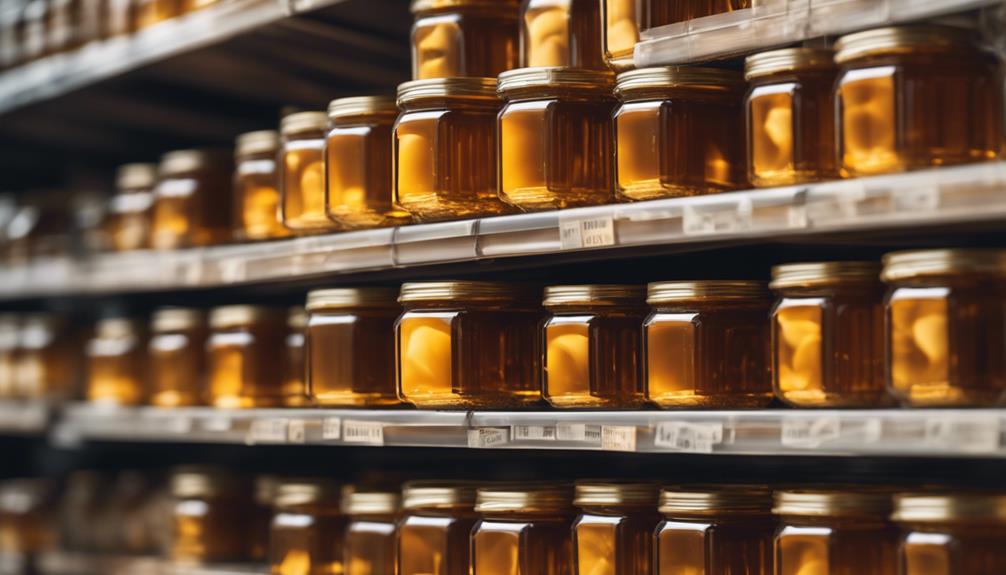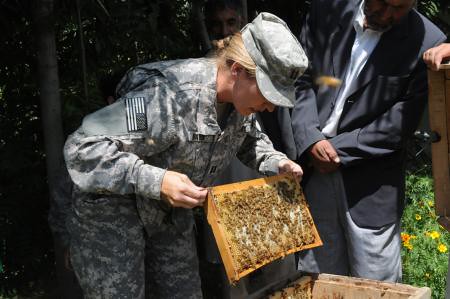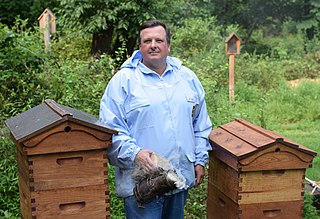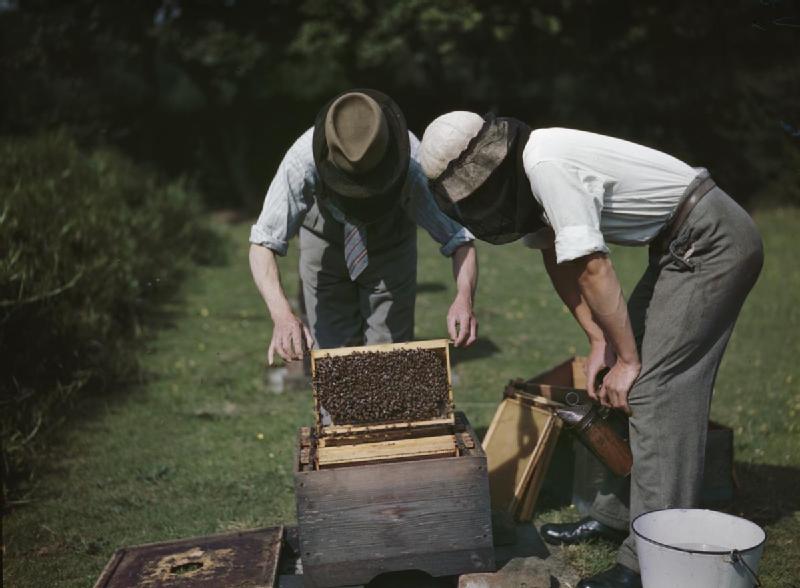
To guarantee honey super frames for winter, keep them in a cool, dry place away from big temperature changes. Seal them tightly to thwart pests and show gratitude for bees' hard work. Check for cracks, mold, or splits to maintain frame integrity. Watch for pests by inspecting the hive entrance regularly. Control moisture levels with good ventilation, moisture-absorbing materials, or a dehumidifier nearby. Opt for a dry, well-ventilated space with good airflow Commercial beekeeping like a shed or garage. Following these steps guarantees a top-quality honey harvest. Your bees will thank you!
Importance of Proper Storage
Properly storing honey super frames during winter is essential for maintaining the quality of your harvest. Safeguarding your precious honey requires a little preparation.
As you gear up for winter, keep in mind that where you store your frames matters. Find a cool, dry place away from pesky pests. It's like giving your honey a cozy winter retreat!

Insulation is key – protect those frames from extreme temperature swings. Make sure they're sealed tight to keep out any unwanted guests.
Your bees worked hard to fill those frames, so show them some love by storing them properly. A little effort now means a sweet reward later!
Inspecting Frames for Damage
Before tucking away your honey super frames for winter, it's important to give them a thorough once-over. Check for cracks that could compromise the integrity of the frames.
Look for any signs of mold, and assess the comb condition to make sure your frames are in top shape for storage.
Check for Cracks
Inspect the frames for cracks before storing them for winter. Cracks can invite moisture and pests, potentially damaging your honey super frames. Here are some tips to help you identify and address any cracks:
- Look closely: Examine each frame carefully for any visible cracks or splits. Use your hands: Feel along the frame to detect any small or hidden cracks. Inspect the edges: Check the edges of the frames where cracks are more likely to occur. Tap gently: Lightly tap the frames to see if any weak spots reveal themselves. Repair promptly: If you find any cracks, consider repairing them before winter storage to maintain the integrity of your frames.
Look for Mold
Check the honey super frames for any signs of mold as part of your inspection Overwintering bees for damage. Mold can develop on frames due to excess moisture, which can harm the quality of your honey.
Look closely at the frames, especially in the corners and crevices where mold tends to grow. If you spot any mold, take action immediately to prevent it from spreading. Cleaning the frames with a mixture of water and vinegar can help eliminate the mold effectively.
It's essential to address mold issues promptly to guarantee the overall health and longevity of your honey super frames. By staying vigilant and tackling mold early on, you can maintain the integrity of your frames and preserve the quality of your honey for the winter months ahead.
Assess Comb Condition
To guarantee the health of your honey super frames for winter storage, evaluating the condition of the comb is crucial. Here are some key points to take into account when inspecting your frames:
- Look for signs of mold or mildew on the comb. Check for any holes or cracks in the wax that might indicate damage. Confirm the comb is free from pests such as wax moths or hive beetles. Verify that the comb is securely attached to the frame and not loose. Assess the overall cleanliness of the comb to prevent contamination.
Pest Prevention Methods
Before you stow away your honey super frames for the winter, take a moment to inspect them for any signs of pests.
It's important to identify and remove any infested frames to prevent the spread of unwanted visitors in your hive.
Hive Inspection for Pests
Examining your hive regularly for pests is essential in maintaining the health of your bee colony throughout the winter months. Here are some tips to help you keep your hive pest-free:

- Monitor Entrance: Check for any unusual activity at the hive entrance, like aggressive behavior or an increased number of dead bees. Inspect Frames: Look for signs of pests such as mites, beetles, or wax moths on the frames during your inspections. Use Sticky Boards: Place sticky boards under the hive to trap and monitor pest activity. Consider Alternative Remedies: Investigate natural pest control methods like essential oils or powdered sugar treatments. Maintain Cleanliness: Keep your hive and surrounding area clean to reduce the risk of pest infestations.
Regular inspections and preventive measures can help your bees stay healthy and strong.
Removal of Infested Frames
When inspecting your hive for pests, if you discover frames that are infested, prompt removal of these frames is necessary to prevent further spread of the infestation.
Infested frames can wreak havoc on your hive if left unchecked, so it's vital to act swiftly. Grab your beekeeping gear, locate the affected frames, and carefully remove them from the hive. Be sure to seal them in a plastic bag to contain the infestation before properly disposing of them.
Controlling Moisture Levels
To maintain ideal conditions for storing honey super frames during winter, it's crucial to regulate moisture levels effectively. Here are some tips to help you control moisture and preserve the quality of your honey:
- Guarantee proper ventilation in the storage area. Use moisture-absorbing materials like silica gel packets. Place a dehumidifier nearby to keep humidity levels in check. Avoid storing frames in damp locations like basements or areas prone to leaks. Consider using moisture barriers such as plastic covers to protect the frames from excess moisture.
Choosing the Right Location
Guarantee the location where you store your honey super frames during winter is dry and well-ventilated to prevent moisture buildup and maintain frame quality. A damp environment can lead to mold growth and damage your frames, impacting the quality of your honey.
Find a spot that allows for good air circulation, keeping your frames safe and sound until the next bee season. Whether it's a shed, garage, or spare room, make certain there's proper airflow to avoid any unpleasant surprises when you check on your frames later.
Rotation and Labeling System
Implementing a systematic rotation and labeling system for your stored Beekeeping for Beginners honey Beekeeping associations super frames is crucial for easy management and quality control. To streamline your process, consider the following tips:
- Color-coded Labels: Use different colors to indicate the age or status of frames. First In, First Out (FIFO): Make sure older frames are used before newer ones to maintain freshness. Regular Inspections: Check frames periodically to identify any issues or changes. Digital Tracking: Utilize apps or spreadsheets to keep detailed records of each frame. Proper Storage: Store frames in a dry, cool, and dark area to preserve their quality.
Frequently Asked Questions
Can Honey Super Frames Be Stored With Other Beekeeping Equipment?
Yes, honey super frames can be stored with other beekeeping equipment. Make sure they are clean and dry before stacking them. Utilize a dry, well-ventilated area to prevent mold growth and protect the frames from pests.

How Often Should Frames Be Rotated During Winter Storage?
Rotate frames every 4-6 weeks during winter storage to prevent mold and guarantee even distribution of resources. Regular checks also help monitor hive health and address any issues promptly. Keep frames in a cool, dry place.
Is It Safe to Store Frames in a Garage or Shed?
Like a bear finding a cozy den, storing frames in a garage or shed can be safe if protected from pests and moisture. Guarantee proper ventilation and shield them from extreme temperatures for best preservation.
What Is the Best Way to Label Frames for Easy Identification?
Label frames with a marker or tape for easy identification. Make sure to include details https://canvas.instructure.com/eportfolios/2874764/lorenzokoii579/How_Many_Hours_a_Week_Should_I_Beekeeping like hive number, date extracted, and honey type. This simple step will help you stay organized during the busy season.
Can Frames Be Stored in Plastic Containers or Bags?
Yes, you can store frames in plastic containers or bags. Make sure they're sealed to prevent pests. Pro tip: adding a desiccant packet helps control moisture. Keep them in a cool, dark place for best preservation.